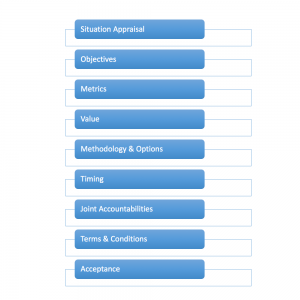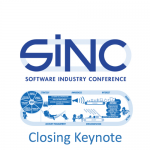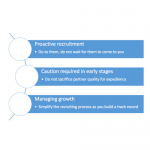How to Deliver Winning Proposals – Part 6
 In the previous posts I have stressed that the proposal is the very last thing to do and that it is essentially just a confirmation of what we have already agreed verbally with the client – except for our fee. I have also stressed that consulting projects must have measurable outcomes. They must produce visible and measurable results.
In the previous posts I have stressed that the proposal is the very last thing to do and that it is essentially just a confirmation of what we have already agreed verbally with the client – except for our fee. I have also stressed that consulting projects must have measurable outcomes. They must produce visible and measurable results.
The objective is not to win all the deals we come across, but to choose and win those that have the highest value for our clients and thus equitable fees for us. Working less hours for more money is the objective of any resource in a capitalistic business setup. Management consulting is no different.
In the previous post I introduced the structure of the proposal and elaborated on the Situation Appraisal.
In this post we will look at the section of the proposal outlining the “objectives” of the consulting engagement.
Objectives
In the early days of my consulting career I mistook inputs for outputs. I thought that doing strategy reviews, making market assessments, running focus groups, providing training and performing situation analysis were genuine outcomes of consulting projects. For many consultants they still are, but I have chosen to change my perceptions.
I have changed my view on consulting engagements because I realized that it was impossible to make reasonable fees on “input projects.” Most consultants produce input. Strategy reviews, market assessments, situation analysis, business model facilitation etc. are all input activities. While I am capable of doing them all very well, the clients had a tendency to postpone the projects and to negotiate the price to a level where I had to say “no thanks.” In 99% of the cases where I said “no thanks” I realized that the clients decided to do nothing. The remaining 1% did some variation of the project with internal resources. Not once did I lose the deal to another consultant.
As you can see from the table of contents of the proposal we have sections called “Metrics” and “Value.” These sections are mandatory, but they are only meaningful if the objectives are output focused.
The purpose of management consulting
As management consultants we are supposed to help our clients improve the performance of their organizations.
As Alan Weiss puts it:
The role of a consultant is to improve the client’s condition.
I strongly subscribe to this.
If we cannot measure the result of our consulting, then how can we know that we have “improved the client’s condition?”
SMART Objectives
The objectives of a consulting assignment should follow the same guidelines as any other business objectives. Using the SMART approach we can help our clients nail the real objectives of a project and not just some intermediary input steps:
- Specific – target a specific area for improvement.
- Measurable – quantify or at least suggest an indicator of progress.
- Assignable – specify who will do it.
- Realistic – state what results can realistically be achieved, given available resources.
- Time-related – specify when the result(s) can be achieved.
We normally don’t charge our clients for our proposals. Maybe we should. We help our clients move the focus from input to output. We help our clients identify the results the engagement should help produce. That in itself is more than most consultants ever achieve through their paid-for engagement. And we haven’t even starting charging yet.
But there are good reasons for this and I will explain those reasons in later posts.
The Five Whys
Getting to the root cause of any problem can be accomplished with the “the five whys” process. 
- Can you help us define a new strategy? – Why do you need a new strategy?
- We have missed our revenue and profit targets the last three years. – Why do you think it is a strategy issue?
- Some of the markets that we have approached have failed completely. – Why do you think they have failed?
- We don’t know exactly, but none of our channel partners perform as expected. – Why do you think your channel partners have not performed as expected?
- We don’t know exactly.- Well, shouldn’t we check this first before we start talking about a new strategy?
In this example we need just 4 whys to understand that starting a strategy project was premature.
The objective of a strategy project is not to formulate a strategy. The objective is to find a repeatable and scalable way to deliver certain business objectives. Failing to deliver business objectives (meet budgets, market share targets etc.) may not be related to the current strategy. It may very well be (and very often is) related to the tactical implementation of the current strategy.
The objective of this project is to find ways to deliver on budgets and other business objectives. Maybe that will entail revisiting the strategy, but that is too soon to conclude.
What client’s want and what client’s need is very often not the same.
Other posts in this series
How to Deliver Winning Proposals – Part 1
How to Deliver Winning Proposals – Part 2
How to Deliver Winning Proposals – Part 3
How to Deliver Winning Proposals – Part 4
How to Deliver Winning Proposals – Part 5
How to Deliver Winning Proposals – Part 7
How to Deliver Winning Proposals – Part 8
How to Deliver Winning Proposals – Part 9
How to Deliver Winning Proposals – Part 10
How to Deliver Winning Proposals – Part 11
How to Deliver Winning Proposals – Part 12








